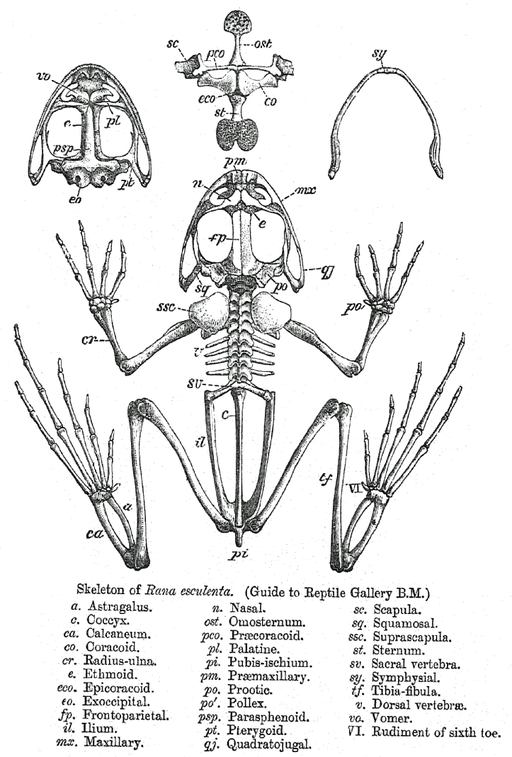
Bildquelle: George A. Boulenger 1890/ Public domain
| zurück Home | Klasse: Amphibia Lurche | Skelett des Frosches Rana esculenta
 Bildquelle: George A. Boulenger 1890/ Public domain | ||
| Allgemeines | 6400 Arten | Tröpfchenpilzinfektion | ||
| O.: Caudata, Schwanzlurche | auch Urodela, Salamander und Molche, 600 Arten | |||
| ÜF.: Cryptobranchoidea | F.: Riesensalamander (Cryptobranchidae) | |||
| F.: Winkelzahnmolche (Hynobiidae) | ||||
| ÜF.: Armmolche (Sirenoidea) | F.: Armmolche (Sirenidae) | |||
| ÜF.: Salamanderverwandte (Salamandroidea)a | F.: Querzahnmolche (Ambystomatidae) | Axolotl (Ambystoma mexicanum) | ||
| F.: Aalmolche (Amphiumidae) | ||||
| F.: Riesen-Querzahnmolche (Dicamptodontidae) | ||||
| F.: Lungenlose Salamander (Plethodontidae) | ||||
| F.: Olme (Proteidae) | Proteus anguinus, Grottenolm | |||
| F.: Rhyacotritonidae | ||||
| F.: Echte Salamander und Molche (Salamandridae) | Lissotriton vulgaris, Teichmolch (L. ) Salamandra atra, Alpensalamander Salamandra salamandra Feuersalamander | |||
| O.: Anura, Froschlurche | auch Salientia, Frösche, Kröten und Unken, 6000 Arten | |||
| UO.: Archaeobatrachia „Urtümliche Froschlurche“ | Schwanzfrösche, Unken, Geburtshelferkröten | |||
| UO.: Mesobatrachia „Mittlere Froschlurche“ | ||||
| UO.: Neobatrachia „Moderne Froschlurche“ | Kröten, Baumsteigerfrösche (Pfeilgiftfrösche), Laubfrösche, Echte Frösche | |||
| O.: Gymnophiona, Schleichenlurche | auch Blindwühlen, Apoda 180 Arten | |||
| F.: Caeciliidae Erdwühlen | ||||
| F.: Chikilidae | ||||
| F.: Dermophiidae | ||||
| F.: Herpelidae | ||||
| F.: Ichthyophiidae Fischwühlen | ||||
| F.: Indotyphlidae | ||||
| F.: Rhinatrematidae Nasenwühlen | ||||
| F.: Siphonopidae | ||||
| F.: Scolecomorphidae | ||||
| F.: Typhlonectidae | ||||
| Teil von | Tetrapoda, Landwirbeltiere | Gnatostomata, Kiefermäuler | Vertebrata, Wirbeltiere | |
Impressum Zuletzt geändert am 25.11.2024 20:59